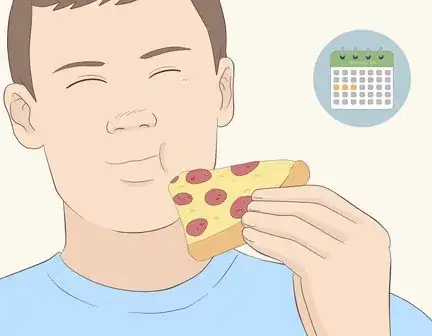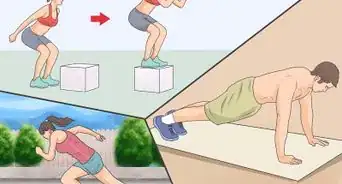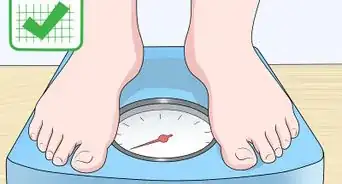This article was co-authored by Adrienne Youdim, MD. Dr. Adrienne Youdim is a Board Certified Internist specializing in medical weight loss and nutrition and founder and creator of Dehl Nutrition - a line of functional nutritional bars and supplements. With 10+ years of experience, Dr. Youdim uses a holistic approach to nutrition that blends lifestyle changes and evidence-based medicine. Dr. Youdim holds a BA from the University of California, Los Angeles (UCLA) and an MD from the University of California, San Diego (UCSD). She completed her residency training and fellowship at Cedars-Sinai. Dr. Youdim holds multiple board certifications awarded by the American Board of Internal Medicine, the National Board of Physician Nutrition Specialists, and the American Board of Obesity Medicine. She is also a Fellow of the American College of Physicians. Dr. Youdim is an Associate Professor of Medicine at UCLA David Geffen School of Medicine and an Assistant Professor of Medicine at Cedars-Sinai Medical Center. She has been featured on CBS News, Fox News, Dr. Oz, National Public Radio, W Magazine, and the Los Angeles Times.
There are 14 references cited in this article, which can be found at the bottom of the page.
This article has been viewed 281,571 times.
You have been exercising, watching what you eat, and doing everything right to reach your weight-loss goal, but one day the scale simply stops moving. How frustrating! Getting stuck at a weight-loss plateau for a few days or even weeks is perfectly normal and happens to most dieters at some point. Spend some time evaluating why you may have hit your weigh-loss plateau, and then try the tips below to get your body back on track to reach your weight-loss goals.
Steps
Evaluating Your Weight-Loss Plateau
-
1Understand how weight loss usually progresses. Most people lose weight very quickly in the first several weeks of a new regimen. While some of this weight is actual body mass, a lot of it is excess water. Once your body has rid itself of this excess water, it is normal for the rate of weight loss to slow down significantly.[1]
- Track your progress and ask yourself: has my weight loss really stopped, or just slowed?
- Experts agree that an ideal rate for safe, lasting weight loss is one to two pounds per week, so perhaps your plateau isn't a plateau after all![2]
-
2Keep track of your caloric intake. Maybe you were very diligent about counting calories at the beginning, or maybe you were able to lose weight initially without monitoring your food intake that closely. In either case, you may be consuming more calories that you realize, and carefully tracking your intake using a food diary or one of the many free calorie counter websites and apps can help you identify exactly how much you are eating and when.[3]
- Once you have a good handle on what you are consuming, you can start to look for problem areas and make adjustments
- If you have been very active, it's also possible you haven't been eating enough calories. If you are working out, your body will require more food. If you restrict yourself thinking that you will lose weight faster, you will actually cause your body to hold on to the weight you currently hold.
Advertisement -
3Reevaluate your caloric needs. As your body gets smaller, it will burn fewer calories and you will need to eat less and less to maintain the calorie deficit that leads to weight loss. If you have not done so lately, enter your weight and activity level into a calorie counter to get an up-to-date number for the number of calories you need.
- Most experts recommend a calorie deficit of 500 calories a day to achieve gradual, lasting weight loss.[4]
- If the calculator tells you that you require 2200 calories per day, you should try to consume around 1700 calories per day to lose a pound per week.
-
4Think about your exercise routine. Have you been exercising consistently? Do you do the same kind of workout every day? Are you doing any kind of resistance training? Lastly, are you relying on the calorie counter on the elliptical machine at the gym to tell you how many calories you actually burned? Think about ways you can change up or improve your exercise routine. Finally, know that the calorie counters on gym machines can be highly unreliable, so if you've been using them to budget your calories, you may have been led astray.[5]
- Elliptical machines are the worst offenders for over-estimating caloric burn. Track the amount of time you work out and the intensity, and use an online exercise calculator to get a better idea of how many calories you actually burned.
- Your body can get used to doing the same activities if you don't change up your workout routine from time to time. If you try something new, you may be engaging different muscles and burning calories in a new way that your body isn't used to, causing you to lose weight.
-
5Look at other factors besides the scale. The number on your scale may not be budging, but there may be other evidence that your body is still changing for the better. Do your clothes fit better? Are your arms bulking up? If you are putting on new muscle, your body will shrink even as the number on the scale stays the same. Better yet, that new muscle will burn more calories than fat, so your weight loss will probably pick up again soon.
- Don't weigh yourself too often. Weight fluctuates due to a variety of factors and it can be misleading. Once a week is more than enough. Try to keep your weigh in around the same day and time each week.
- Be patient and remember that not all plateaus are created equal. If you are making progress in other areas, you may just need to wait another week for the number on the scale to start falling again.
-
6See your doctor for a check-up. If you've analyzed all the possibilities and tried everything, but still can't get your weight loss back on track, schedule an appointment with your doctor. She might have some additional ideas for you, and can also order blood work to check for a hormone imbalance. You may be suffering from an undiagnosed disorder such as thyroid disease, insulin resistance, or polycystic ovary disease that is preventing you from losing weight.[6]
Overcoming the Weight-Loss Plateau
-
1Change up your workouts. When you do the same kind of exercise over and over, your body gets more efficient at that exercise and may start burning less calories to get it done. Mix things up and add some variety to your routine, and you are likely to see an improvement.[7]
- Add some interval training to your normal walking or jogging program for a huge caloric boost.
- Try a new kind of fitness class or activity.
- There are hundreds of free fitness videos available on YouTube and other sites like Fitness Blender. You could try a new kind of workout every single day!
- Meet with a personal trainer to get new ideas and create a routine that will optimize your weight loss.
-
2Add strength training. Adding muscle mass increases the number of calories you burn every day and makes weight loss easier. Add some strength or resistance training to your routine to get that scale moving again.[8]
- Strength training doesn't require an expensive gym membership. You can get started with some inexpensive lightweight dumbbells and go from there.[9]
- To avoid putting on a lot of muscle bulk, focus on lots of reps using smaller weights.
- Women often worry about lifting weights and becoming too "bulky," but unless they are actively trying to gain muscle, this won't happen. Women will gain muscle by lifting, but they won't bulk up because they have lower levels of testosterone.
- There are also many great strength-building exercises you can do with no equipment whatsoever! These include pushups, squats, step-ups, and dozens more.[10]
-
3Break out of a food rut. It's easy to fall into the habit of eating the same food day after day, which can lead to boredom and overeating, and may train your body to become too efficient at digesting certain foods. Shaking up your diet might be just the thing to get past your weight-loss plateau.[11] [12]
- Try adding some new foods to your routine, especially fruits and vegetables.
- Change your eating schedule around. Try making breakfast your largest meal of the day, or breaking up 3 large meals into 6 smaller ones.
- Eating throughout the day keeps your metabolism going.
- Switch out the plates: instead of dishing out your salad on a small plate, and your entrée on a large one, do the opposite!
- Try eating something with casein protein before bed (like cottage cheese). It takes a long time for your body to digest this type of protein, causing your metabolism to work even while you sleep.
-
4Eat more protein. Numerous studies have shown that a protein-rich diet can help dieters lose more weight by improving satiety (the feeling of fullness) throughout the day, and increasing muscle mass. Adjust your diet to include more protein, and try to space your protein intake out throughout the day.[13]
- If you increase your protein intake, be sure to decrease your intake of carbohydrates and/or fats to make up for it. Weight loss still requires a calorie deficit, regardless of what kind of calories you are consuming.
-
5Eat a bigger breakfast. If you typically skip breakfast, or only eat a light meal in the morning, shifting more of your calories to the A.M. can help you lose more weight. A breakfast rich in protein has been shown to be especially beneficial for those wishing to lose weight.[14]
- Start your day with some scrambled eggs, or a protein shake.
- Try a protein-enriched cereal for an easy and convenient breakfast treat.
- Never skip breakfast. The worst breakfast that you can have is no breakfast.
-
6Get more sleep. Not getting enough sleep taxes your body, slows your metabolism, and makes you more likely to overeat during the day. If you wake up feeling tired and sluggish, try going to bed an hour earlier for a week. Not only are you likely to feel better in general, the number on that scale will likely start dropping again.
-
7Take a few days off from dieting. Sometimes your body just needs a break, and many fitness experts recommend taking time off from a calorie-restricted diet as a way to get past a diet plateau. The goal is not to go bananas and eat everything in sight, but simply to return your caloric intake to the base level needed for maintenance, 1800 to 2400 calories per day for most people, for three days. When you resume your regular diet, you should see a noticeable improvement right away.[15]
Lose Weight the Right Way with this Expert Series
References
- ↑ http://www.mayoclinic.org/healthy-lifestyle/weight-loss/in-depth/weight-loss-plateau/art-20044615
- ↑ http://www.mayoclinic.org/healthy-lifestyle/weight-loss/in-depth/weight-loss/art-20047752
- ↑ http://www.jillianmichaels.com/fit/lose-weight/break-through-weight-loss-plateau
- ↑ http://www.health.com/health/gallery/0,,20454528,00.html
- ↑ http://www.shape.com/fitness/cardio/how-inaccurate-are-calorie-counters-gym
- ↑ http://www.jillianmichaels.com/fit/lose-weight/break-through-weight-loss-plateau
- ↑ http://www.sharecare.com/health/types-exercise/causes-fitness-weight-loss-plateau
- ↑ http://www.oprah.com/health/Weight-Loss-Advice-Fitness-Plateau-Dr-Katz
- ↑ http://www.shape.com/fitness/workouts/easiest-strength-training-plan-ever/
- ↑ http://greatist.com/fitness/50-bodyweight-exercises-you-can-do-anywhere
- ↑ Adrienne Youdim, MD. Board Certified Internist. Expert Interview. 11 September 2020.
- ↑ http://www.washingtonpost.com/lifestyle/wellness/how-to-break-out-of-a-food-rut/2015/03/30/be98f99c-cf48-11e4-a2a7-9517a3a70506_story.html
- ↑ https://www.helpguide.org/articles/healthy-eating/choosing-healthy-protein.htm
- ↑ http://www.medicalnewstoday.com/articles/245588.php
- ↑ http://www.jillianmichaels.com/fit/lose-weight/break-through-weight-loss-plateau
About This Article
To break a weightless plateau, try changing your workout routine, like switching out your usual run with a fitness class. Alternatively, add strength training to your workout, since increasing muscle will help you burn calories faster. In addition to changing your workout, increase your protein intake with foods such as eggs and legumes, which have been shown to increase muscle and help you feel full. You can also try going to bed an hour earlier, since a lack of sleep slows down your metabolism. For advice from our Nutrition co-author on how to re-evaluate your calorie needs as you lose weight, read on!















































































